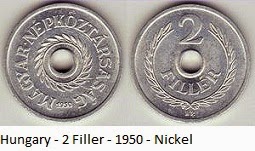CHAPPIDI ABHIRATH REDDY
C/O COL GKS REDDY
Secunderabad - 500015
Hungary Coins
The forint (sign: Ft; code: HUF) is the currency of Hungary. It is divided into 100 fillér, although fillér coins are no longer in circulation. The introduction of the forint on 1 August 1946 was a crucial step of the post-WWII stabilization of the Hungarian economy, and the currency remained relatively stable until the 1980s. Transition to market economy in the early 1990s deteriorated the value of the forint, inflation peaked at 35% in 1991. Since 2001, inflation is single digit and the forint was declared fully convertible.[2] As a member of theEuropean Union, the long term aim of the Hungarian government is to replace the forint with the euro.
The forint's name comes from the city of Florence, where golden coins were minted from 1252 called fiorino d'oro. In Hungary, florentinus (later forint), also a gold-based currency, was used from 1325 under Charles Robert and several other countries followed its example.
Between 1868 and 1892 the forint was the name used in Hungarian for the currency of theAustro-Hungarian Empire, known in German as the gulden or florin. It was subdivided into 100krajczár (krajcár in modern Hungarian).
The forint was reintroduced on 1 August 1946, after the pengő was rendered almost worthless by massive hyperinflation in 1945-46—the highest ever recorded. The process was managed by the Hungarian Communist Party, which held the relevant cabinet seats. The forint's success was exploited for political gains, contributing to the Communists' takeover of complete power in 1948-49. The forint replaced the pengő at the rate of 1 forint = 4×1029 pengő—dropping 29 zeroes from the old currency. In fact, this was an imaginary exchange rate. With the highest value note being 100 million B. pengő (1020 pengő), the total amount of pengő in circulation had a value of less than 0.1 fillér. Of more significance was the exchange rate to the adópengőof 1 forint = 200 million adópengő.
Historically the forint was subdivided into 100 fillér, although fillér coins have been rendered useless by inflation and have not been in circulation since 1999. The Hungarian abbreviation for forint is Ft, which is written after the number with a space between. The name fillér, the subdivision of all Hungarian currencies since 1925, comes from the German word Heller. The abbreviation for the fillér is f, written also after the number with a space in between.
Note - Some of the images of coins in my collection, have been taken from the Gallery to the extent available, to save on time & effort involved in photography & editing.












No comments:
Post a Comment